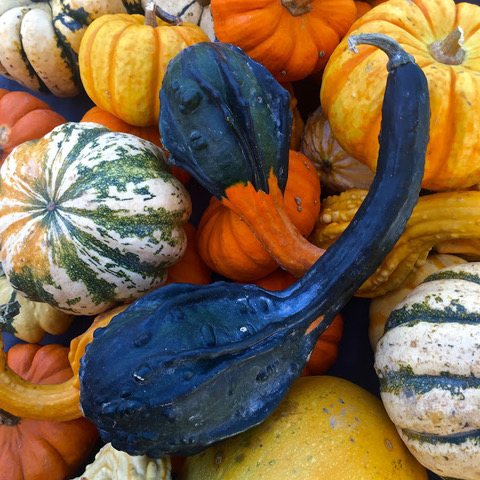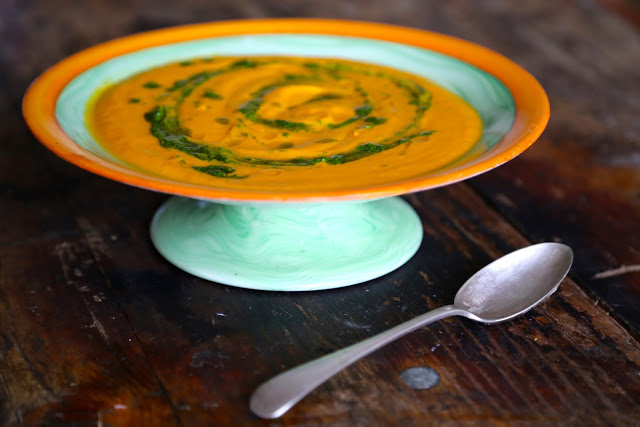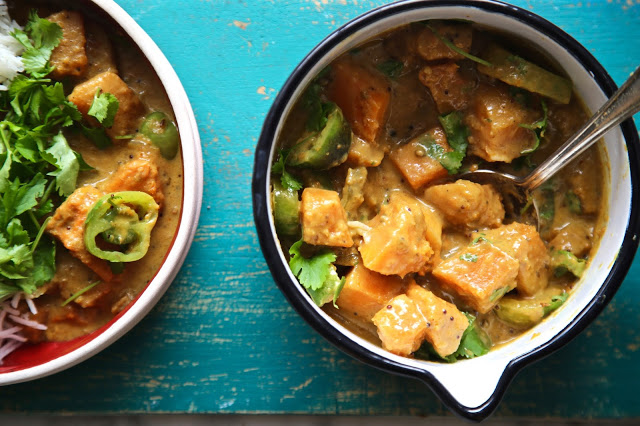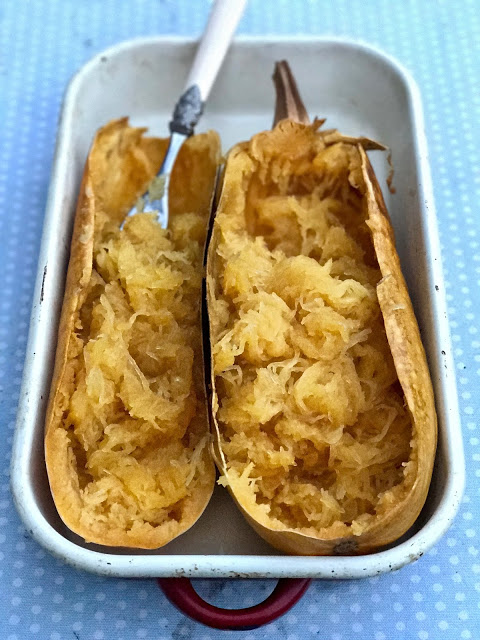
We think of pumpkins as an autumnal North American food: although I was disappointed to discover that they usually buy canned when baking pumpkin pie. There is a wide selection of pumpkins and squashes: from giant pin cushion style of Turban Squash, to spaghetti squash, or the dense sweet flesh of acorn squash and butternut. Pumpkin can be found in Mexican, Japanese, Indian and Italian cuisine. Squash are a vegetable that improves with time: they can be matured over from last year, deepening in flavour, if kept in a cool dry place. Note that the enormous pumpkins that are carved into lanterns aren’t the best for eating, being watery and tasteless.
Halloween occurs as autumn turns to winter: the wet amber leaves have been swept up and the nights begin to frost. Here are a few tips and recipes to expand your pumpkin repertoire and of course what wines go best.
Interesting squashes/pumpkins you should try:
- Butternut squash. I love it roasted and tossed into salads or served with couscous, a few pomegranate seeds and parsley. The ‘coquina’ variety is nicely sweet.
- Spaghetti squash. Once baked, the centre can be forked into spaghetti-like strands. You can treat it like courgetti, a gluten-free replacement for pasta and the latest trend for fashionable ‘clean’ eaters. Or add lashings of salty butter and parmesan, as I do.
- Tromboncini. Trombone-shaped Italian squash. When young, slice up and use like courgette; when older, use like squash.
- Gem squash. Wonderfully sweet: stuff and bake.
- Acorn squash. Another small squash. Can be pureed into soup or stuffed.
- Onion squash. Small, baked, mixed with cheese. This is great on toast.
- Kabocha squash. Popular in Japan. Perfect simply roasted with soy sauce, ginger, sesame seeds and served with sushi rice.
- Hokkaido. Teardrop-shaped, deep red/orange squash. Use in a tart, a soup or simply roasted.
- Delicata squash. Italian from Lombardy. Difficult to find in the UK but it’s easier to chop up than other squashes and the skin is edible so no peeling required. Roast with a little salt.
- Crown Prince. Large blue/grey skinned squash with sweet orange flesh inside.
- Harlequin. Pointy decorative squash is also good to eat.
- Turban squash. Spectacular – looks just like a Turkish hat.
Top tips for squash and pumpkins:
- Use every part of the pumpkin.
- You can save the seeds and roast them. Just brush/scrape off most of the flesh, give them a quick wash and roast with a little salt and olive or pumpkin seed oil.
- Austria grows especially large pumpkin seeds which they turn into cold-pressed dark green Styrian oil. Dip bread into it or drizzle over roast pumpkin.
- I use pumpkin seeds in bread or scattered over salads.
- The skins or shells are effective as bowls for soup or as below, for a soufflé.
- The flowers can be used for a Mexican squash flower soup.
- Squash is also a brilliant carbohydrate filler for those who are gluten free.
- For the best tasting winter squash, experiment with some of the other cultivars available.
Pumpkin Soup Recipe:

The classic pumpkin recipe, you can use most pumpkins for soup. Decorate with herbs chopped finely into oil, pumpkin seeds, croutons, a swirl of yoghurt or a grating of parmesan cheese. Serve with bread and you have a warming autumnal meal.
Serves 6
3tbsp olive oil
1 large brown onion, diced
one medium pumpkin, seeded, peeled, chopped roughly, approximately a kilo of flesh
1.5 litres of vegetable stock
1/2tsp mace
100ml of single cream
Salt and pepper to taste
Using a wide, tall, large saucepan, heat the oil then soften the onion. Add the pumpkin chunks, cooking until slightly golden on the edges. Then add the stock and mace. Cook for 15 minutes then use a hand blender or a table top blender to process the chunks into a soup. Add the single cream. Season to taste. Serve warm.
To make it vegan: replace the single cream with coconut milk. You can add a finely diced red chilli to add an exotic vibe to the soup.
What to drink with this soup:
I’d choose a medium bodied red wine or a sherry to match this hearty soup.
- Farnese Fantini Sangiovese IGT Terre Di Chieti 2015 £9.95, Italy
- The Liberator Episode 10 –Midnight at the Lost and Found 2013 £13.95, South Africa
- Maestro Red, Demorgenzon, 2015 £15 (on sale, down from £18), South Africa
- Fontodi Chianti Classico, 2013, £20, Italy.
- Dry Oloroso ‘Pata de Gallina’ Lustau, Jerez NV(50cl bottle) £19.50, Spain. I’d add a little of this dry sherry to the soup.
Pumpkin curry recipe

In India they tend to use small ‘tinda’ pumpkins for curry (try Tayyabs in London’s East End for a fantastic version) but I like to use a firmer fleshed squash such as butternut. This recipe uses up other autumnal ingredients such as green tomatoes – the ones that haven’t had enough time to ripen on the vine before blight attacks the plant.
Serve with rice and yoghurt for a full meal.
Serves 4-6
Ingredients
3 dried kashmiri chillies, soaked, deseeded.
50ml of ground nut or vegetable oil
1tsp mustard seeds
1 large black cardamom
1tsp of cumin seeds
1tsp of coriander seeds
1 cinnamon stick
2 bay leaves
A pinch of cloves, ground
1 Butternut squash, peeled, deseeded and cubed
3tbsps of tamarind paste
3 cloves of garlic, crushed
3cm of fresh ginger, grated
3cm of fresh turmeric root, grated
10 green tomatoes (red or yellow can also be used but green adds a little acidity)
1tbsp of sea salt (less if using table salt)
250ml of coconut milk (buy a good brand without thickeners or additives)
30g of fresh coriander leaves (or one pot)
Method
Soak the chillies in boiling water. In the meantime, heat up the oil a deep frying pan or saucepan.
Add the mustard seeds and wait until they pop. Add the cumin, coriander, cinnamon, bay and cloves. Add the butternut squash to the pan, stirring on high heat then lower the heat to medium.
Remove the chillies from the boiling water, snipping off the stems and seeds. Place them in a blender with the tamarind paste and a little water. Blend until you have a watery paste. Add this chilli tamarind paste to the pan and stir.
Add the garlic, then grate in the ginger and turmeric. Add the green tomatoes, followed by the salt and coconut milk.
Cook on a medium to low heat until the butternut squash is tender. Finally, add the fresh coriander leaves and serve with rice.
What to drink with pumpkin curry:
A crisp but full bodied white is just the ticket to stand up to the spices and slight heat of this recipe.
- Domaine de Vedilhan Serica Viognier 2015 £9.25, France
- Schloss Gobelsburg, Steinsetz Gruner Veltliner Kamptal Reserve 2014 £19, Austria
- Paul Cluver Noble Late Harvest Riesling, 2014 £15 Half Bottle, South Africa
- Paul Cluver Sauvignon Blanc 2016 £11.95, South Africa
Spaghetti Squash Recipe:

This is a fun squash: once baked, you fork over the inside flesh (having removed the seeds), and it resembles spaghetti. Add butter and cheese and you have a low carb meal with little effort.
1 spaghetti squash, whole
Salt and Pepper to taste
Toppings:
Butter
Cheese, either parmesan or cheddar.
Jalapeno peppers, sliced.
Preheat the oven to 180cº for 20 minutes.
Place the entire squash in a baking tray and roast for one hour or until soft when poked through with a metal skewer.
Remove from the oven and slit lengthways down the middle. Scoop out the seeds and fork over the flesh.
Add the toppings of your choice.
What to drink with spaghetti squash:
A white chardonnay is often recommended for spaghetti squash but the following picks will also quench your thirst nicely!
- Casas del Bosque, Chardonnay Reserva 2015 £9.95, Chile
- La Flor Malbec Rose, Pulenta Estate 2016, £11.95, Argentina (New world rosé)
- Mullineux Kloof Street Swartland rouge 2015 £15, South Africa
- Chateau Los Boldos Tradition Reserve Merlot 2015, £8.95, Chile
What do you like to drink with pumpkin? Are you adventurous with squash? What Halloween dishes will you be making and what will you drink with them?
Do let us know in the comments…
